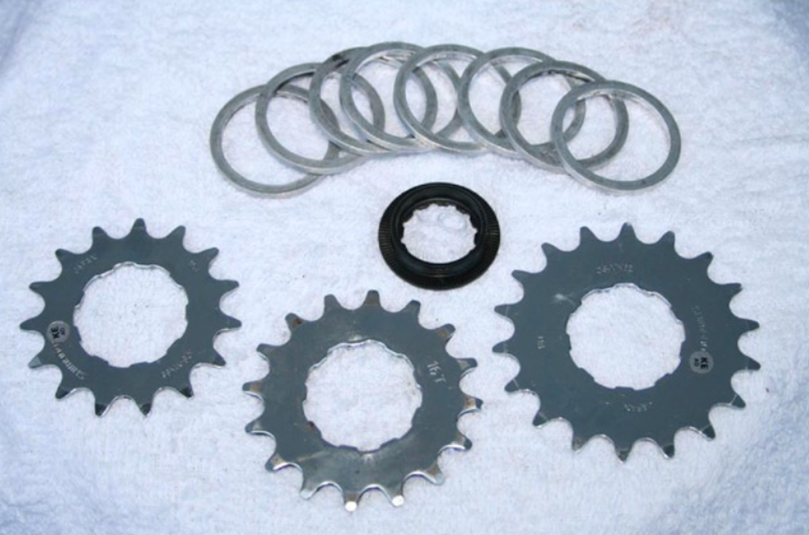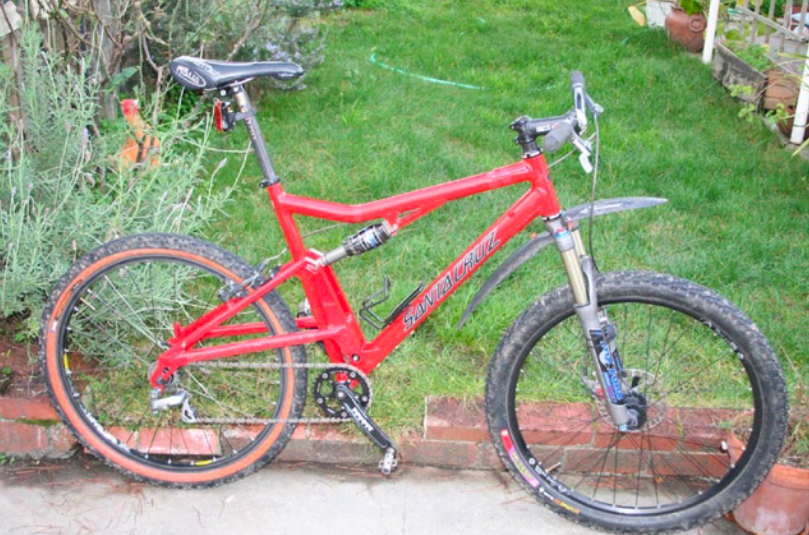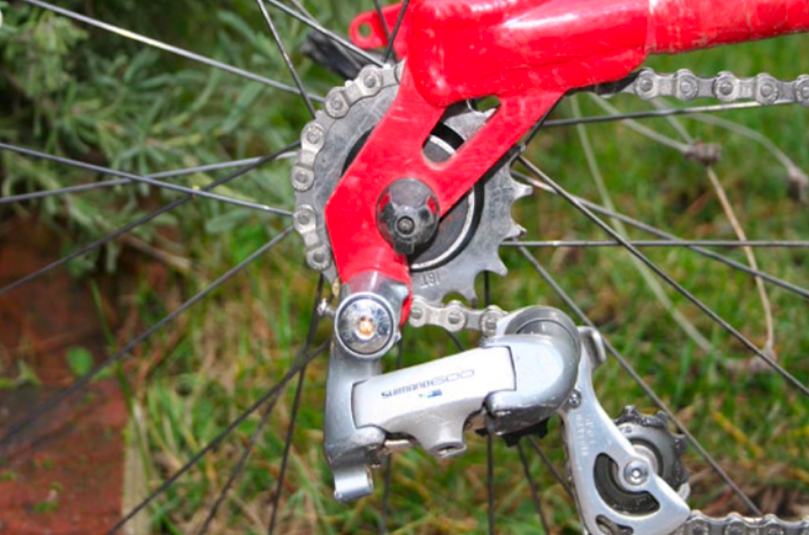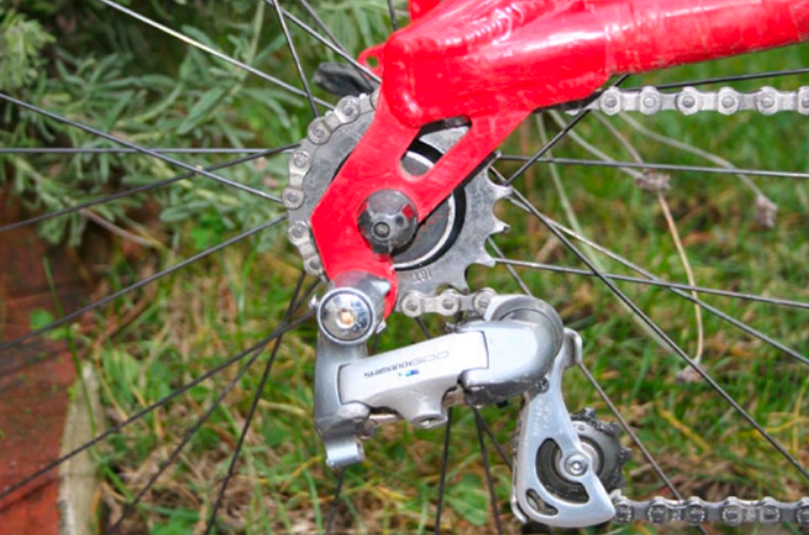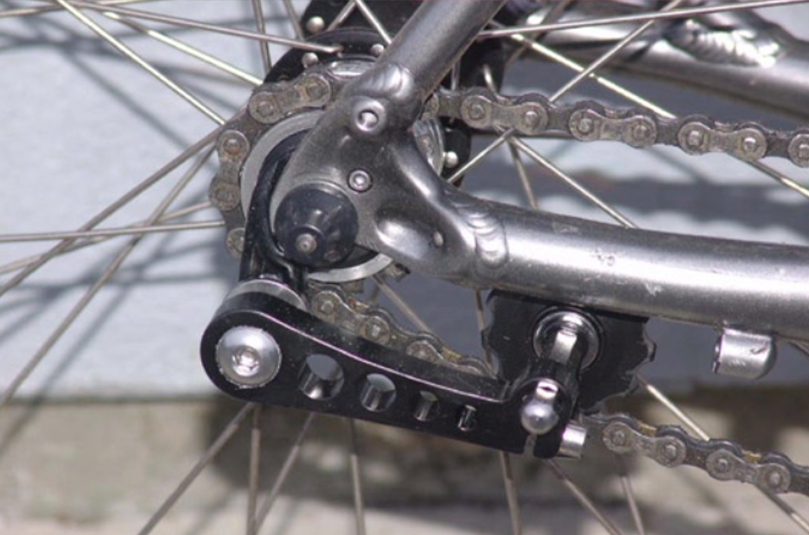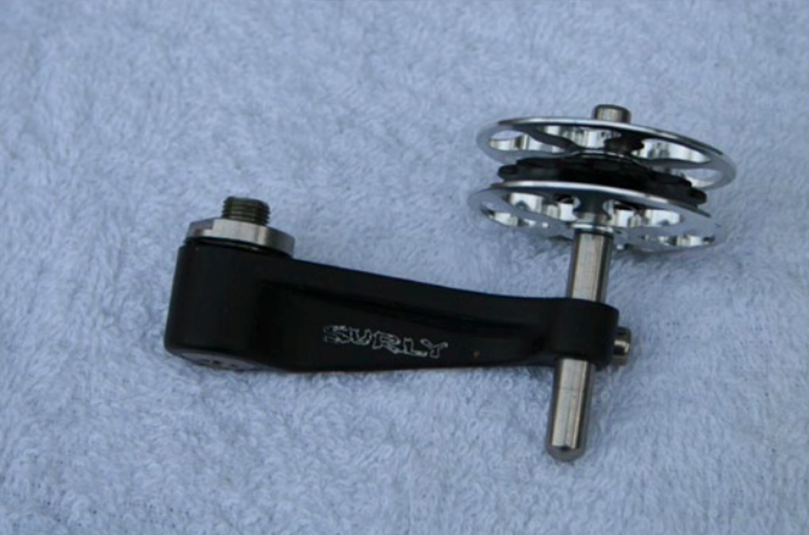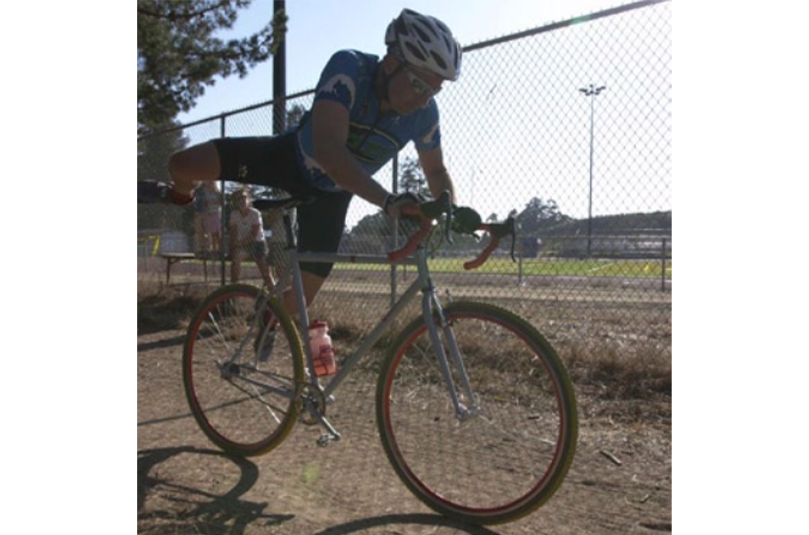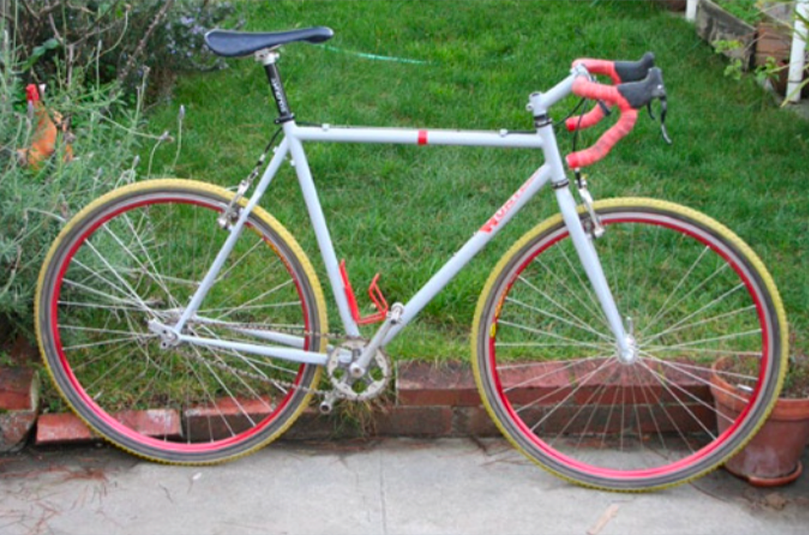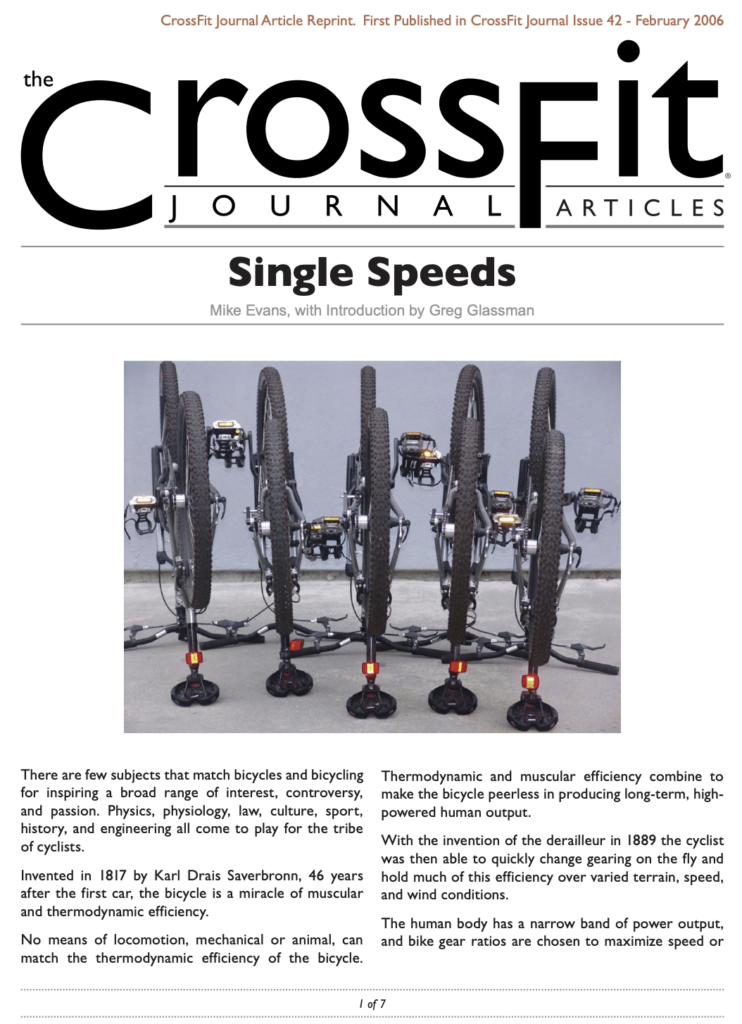By Mike Evans with Introduction by Greg Glassman
There are few subjects that match bicycles and bicycling for inspiring a broad range of interest, controversy, and passion. Physics, physiology, law, culture, sport, history, and engineering all come to play for the tribe of cyclists.
Invented in 1817 by Karl Drais Saverbronn, 46 years after the first car, the bicycle is a miracle of muscular and thermodynamic efficiency.
No means of locomotion, mechanical or animal, can match the thermodynamic efficiency of the bicycle.
Thermodynamic and muscular efficiency combine to make the bicycle peerless in producing long-term, high- powered human output.
With the invention of the derailleur in 1889 the cyclist was then able to quickly change gearing on the fly and hold much of this efficiency over varied terrain, speed, and wind conditions.
The human body has a narrow band of power output, and bike gear ratios are chosen to maximize speed or distance for the minimum effort. This is the advantage of multi-speed bikes – maintaining a constant cadence (pedal rpm) and load to maximize performance.
Performance is optimized with multispeed bikes by selecting gearing that allows for both maximum stamina (localized muscular endurance) and maximum cardiorespiratory endurance for any given power output. This optimization, at both high and low power outputs, occurs at relatively high cadences.
Even high, unsustainable, power outputs like those common to sprint cycling are found at high cadences.
The CrossFit charter of “functional movement, high intensity, and constant variance” encourages combinations of cadence and load not found or commonly accepted in either sprint or endurance cycling. High load, low cadence cycling is almost heretical in cycling communities.
For CrossFitters, the value in bicycle training is only peripherally or remotely tied to improved cycling efficiency and performance. More important is the training opportunity to vary the load and velocity matrix at all power outputs. (Interestingly a little noticed study commissioned by StairMaster Corporation in the mid 90’s concluded that regularly varying the load-velocity matrix during the course of workouts was a uniquely potent stimulus to GPP.)
We could pull this off with a multispeed bike by regularly and deliberately selecting inefficient gearing, or shifting randomly, and CrossFitters living in flatlands may find this to be their best option, but the same effect can be found with less mental energy by riding a single-speed bike on undulating terrain.
There is absolutely NO advantage to either enjoyment or fitness in multispeed bikes. Accepting this, the single speed enthusiast has:
- Traded efficiency for greater fitness
- Fully embraced the sting of the hill climb
- Found a more physical, whole body, technical, or “athletic” ride
- Uniquely increased his strength through bicycling
- Discovered the thrill of a simpler, freer, more elegant riding variant
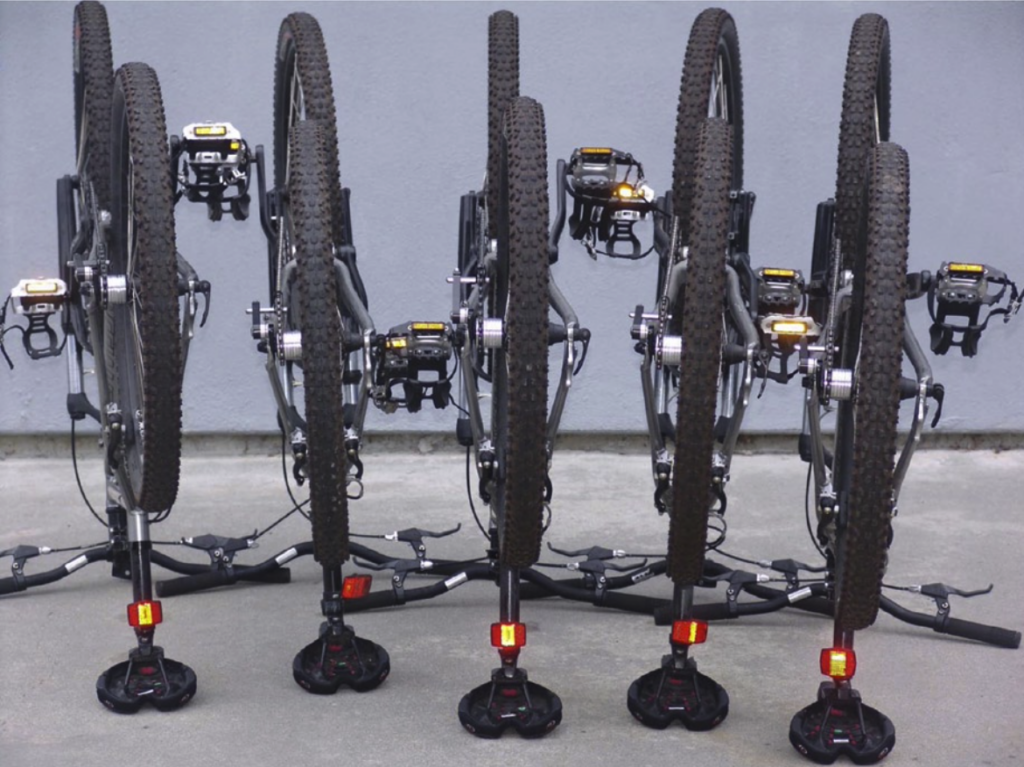
At CrossFit Santa Cruz we recently converted our fleet of mountain bikes to single-speeds. Our mountain bikes were originally seen as a vastly more economical, versatile, and enjoyable alternative to stationary bikes, but we quickly learned that too many athletes had no idea how or when to shift, few admitted as much, and mandatory review and instruction on shifting didn’t help. Nearly every use seemed to involve breakdowns, repairs, and too many walked bikes.
The first time I ever saw a singlespeed mountain bike was over 15 years ago. We were on a group ride and my friend Brent showed up riding one. I really thought he had lost his marbles as we rode the flat pavement out to the trails. He looked like a sewing machine at full RPM! As we hit the first dirt incline, Brent simply rode away from us and we didn’t see him again until the top of the hill. Soon another friend acquired a single speed and started tearing our legs off on every ride. I quickly decided I had to have one.
Originally, to get a single speed, you had to take an old steel frame and weld on rear horizontal dropouts (figure 1) or buy a custom frame. Old aluminum frames can’t be rewelded due to the heat treating process used to make them. The problem is that most bikes now come with vertical dropouts (figure 2) and it’s impossible to get enough tension on the chain to make it operate as a single speed. Besides changing gears, the rear derailleur on geared bikes also acts as a chain tensioner. Luckily for me, I was able to purchase a used steel frame that I then took to a local frame builder and had modified for single-speed use.
This bike became affectionately known as the Pain Pony (figure 3). I learned more about riding mountain bikes from this one bike than from all my other bikes combined. Single-speed riding is an effective teacher of technique. It will:
- Smooth out your pedal stroke. For years, European road pros have trained on single-speed (fixedgear) bikes in the off season to help redefine their pedal stroke (figure 4).
- Teach you where to place your pedals in technical situations.
- Make you acutely aware of the terrain or road in front of you.
- Teach you how to accelerate over the crown of hills.
- Tell you everything you ever wanted to know about momentum.
- Show you that you really can ride that technical section or hill without shifting into the granny gear or small chain ring.
- Force you to vary your rpm (crank speed) from the ridiculously low level of 30 rpm to the very high level of 130 rpm. (Sometimes while I’m climbing I feel like I’m on a Roman slave ship with some big bloke in the back pounding tempo on his drum.)
Single speeds are also great if you live or ride in a place with inclement weather; there are fewer parts to clog up and to wear out. Beside all of this, single speeds are just a blast to ride.
Nowadays you can purchase a complete single speed, as many manufacturers have smelled money and jumped into the fray. And there are a plethora of aftermarket manufacturers in the game now as well. You can now purchase components such as single-speed-specific hubs, wheel sets, crank sets, single-cog adapters for multigeared freewheels, and chain tensioning devices. The beauty of all this manufacturer involvement is that almost any bike in your garage can now be converted to a single speed.
The two most important things in building a single speed out of almost any geared bike are chain line and chain tension. Chain line refers to the angle of the chain between the front chain ring and the rear cog (figure 5). You want the chain as straight as possible, or, if you can imagine, exactly parallel to the rear wheel. The reasons for this are several. If the chain is angled between the front chain ring and rear cog, it will experience undue side load (figure 6), which will make the chain wear out sooner—or, worse yet, cause it to break. If the chain breaks under extreme load while standing, you could injure some very sensitive soft tissue!
There are a lot of variables to setting a straight chain line depending on what system you use, but it basically involves using spacers to adjust the rear cog between the cassette lock ring and the end of the free hub (figures 7 and 7.5). On the front chain ring, you are basically limited to which side of the crank arm you want to run the chain ring. You most likely will have to buy chain ring bolts that are made for a single chain ring (figure 8).
Getting enough chain tension on a bike with horizontal dropouts is easy: just pull the rear wheel aft (back) and tighten the axle bolts or quick release. On a bike with vertical dropouts you will need some type of tensioning device. This could be an old derailleur, single-speed-specific tensioners (figures 15 and 15.5), rear singlespeed wheel hubs with an eccentric axle, or a custom singlespeed frame (with horizontal dropouts or with an eccentric bottom bracket – figure 9). Whichever tensioning device you use, make sure you get as much chain as possible to wrap around the rear cog (figure 10). When using a derailleur as a tensioner, I have had the best luck using a short-cage road one, but any derailleur will work. Using the proper chain length with a derailleur will pull the derailleur cage forward and at the same time achieve enough chain wrap.
You can also make a full suspension mountain bike into a single speed (figure 11). Full-suspension bikes, however, do strange things to chains. On my bike, when the suspension is fully compressed, tension on the chain is increased, which pulls the derailleur forward (figures 12 and 13). If you do decide to convert a full-suspension bike, cycle the suspension a few times and see what the chain and the derailleur are doing. On my bike if I were to make the chain too short and I fully compressed the suspension, I would run the risk of ripping the derailleur right out of the frame, causing catastrophic (read: very expensive) failure.
Gearing for a single speed is largely about where you live and ride. I won’t go too far into it other than to say most single-speed mountain bikes run a gear ratio of 2 to 1. To determine the ratio, divide the number of teeth on the front chain ring by 2 to get the number of teeth on the rear cog. For example, a 34-tooth chain ring and 17-tooth rear cog is a ratio of 2 to 1. (A good ratio for a road bike is 2.94 to 1 [e.g., 48 teeth front, 16 teeth rear]). Your gearing may vary according to the terrain that you ride and personal preference.
Converting a bike doesn’t require a huge number of tools but, unfortunately, several of the them are bike-specific. Not only that, but even bike-specific tools, such as crank arm removers, may be different from one generation to the next generation of the same component manufacturer. Also, tools can vary according to component manufacturer—e.g., Shimano vs. Campagnolo. My toolbox has grown immensely in the last few years because of this. If you are inclined to tackle a single-speed conversion project but don’t have the proper tools, I suggest contacting any cyclist you know or the nearest cycling club or cycling co-op to see if you can use their tools. Working on a bike is not rocket science, but the parts are small and it is easy to overtorque and break them. Use common sense! If you are not mechanically inclined or can’t find any tools, your local bike shop would likely be happy to help.
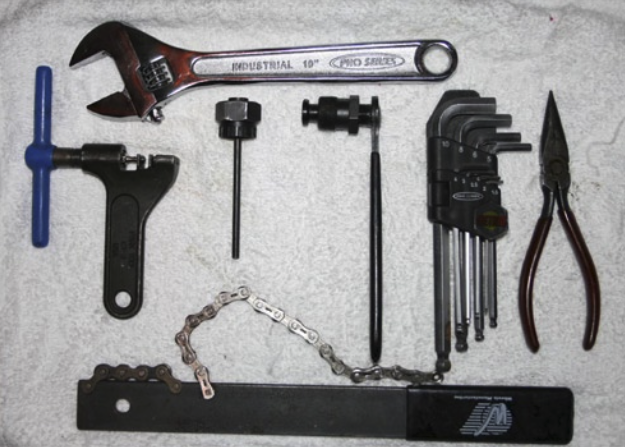
Tools needed (figure 14):
- Chain tool
- Chain whip
- Cassette lock ring tool
- Crank arm remover
- Metric Allen wrenches
- Pliers
- A nice degreaser would also be good. I suggest Dawn dish soap or Simple Green or some type of citrus cleaner for the tough stuff. You might as well clean everything while it’s apart. (Do not soak the chain in Simple Green or citrus cleaner for very long, as this has been proven to weaken the side plates on the chain.)
As you may have noticed, I didn’t mention any of the physiological aspects of riding a single speed. I will leave that to the professionals. I can tell you that riding a single speed is a blast because the bikes are lighter, much quieter (no missed shifts, no chain slap, and fewer cables and housing beating the frame), and insanely simple: just pedal! Maybe it’s because most of us started on singlespeed bikes when we were kids (BMX, Stingray, etc.) and it’s a reminder of the freedom they signified.
This article, by BSI’s co-founder, was originally published in The CrossFit Journal. While Greg Glassman no longer owns CrossFit Inc., his writings and ideas revolutionized the world of fitness, and are reproduced here.
Coach Glassman named his training methodology ‘CrossFit,’ which became a trademarked term owned by CrossFit Inc. In order to preserve his writings in their original form, references to ‘CrossFit’ remain in this article.
Greg Glassman founded CrossFit, a fitness revolution. Under Glassman’s leadership there were around 4 million CrossFitters, 300,000 CrossFit coaches and 15,000 physical locations, known as affiliates, where his prescribed methodology: constantly varied functional movements executed at high intensity, were practiced daily. CrossFit became known as the solution to the world’s greatest problem, chronic illness.
In 2002, he became the first person in exercise physiology to apply a scientific definition to the word fitness. As the son of an aerospace engineer, Glassman learned the principles of science at a young age. Through observations, experimentation, testing, and retesting, Glassman created a program that brought unprecedented results to his clients. He shared his methodology with the world through The CrossFit Journal and in-person seminars. Harvard Business School proclaimed that CrossFit was the world’s fastest growing business.
The business, which challenged conventional business models and financially upset the health and wellness industry, brought plenty of negative attention to Glassman and CrossFit. The company’s low carbohydrate nutrition prescription threatened the sugar industry and led to a series of lawsuits after a peer-reviewed journal falsified data claiming Glassman’s methodology caused injuries. A federal judge called it the biggest case of scientific misconduct and fraud she’d seen in all her years on the bench. After this experience Glassman developed a deep interest in the corruption of modern science for private interests. He launched CrossFit Health which mobilized 20,000 doctors who knew from their experiences with CrossFit that Glassman’s methodology prevented and cured chronic diseases. Glassman networked the doctors, exposed them to researchers in a variety of fields and encouraged them to work together and further support efforts to expose the problems in medicine and work together on preventative measures.
In 2020, Greg sold CrossFit and focused his attention on the broader issues in modern science. He’d learned from his experience in fitness that areas of study without definitions, without ways of measuring and replicating results are ripe for corruption and manipulation.
The Broken Science Initiative, aims to expose and equip anyone interested with the tools to protect themself from the ills of modern medicine and broken science at-large.
Support the Broken Science Initiative.
Subscribe today →
recent posts
Medical Society Webinar with David Wiss








